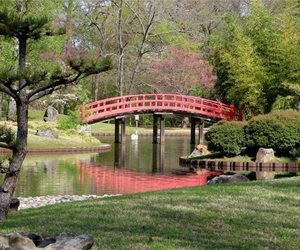Japanese Garden Bridges & Pavilions
Examples of Japanese garden structures
A bridge in a Japanese garden can be functional, decorative, or both. Photo used under Creative Commons from Karen Dorsett.
Large Japanese gardens usually contain two structures: a bridge and a pavilion. If you have the space, you may want to consider adding one, or both of these structures to your own Japanese inspired garden.
Japanese garden bridges are usually simple in construction. They can be functional, providing garden visitors with a path across a stream or pond, or simply decorative. The first common style of bridge is the simple wooden arch bridge. The second style is a flat, zigzag bridge. According to ancient beliefs, zigzag bridges keep evil spirits at bay because the spirits are only capable of traveling in straight lines. Bridges have two symbolic representations in the Japanese garden. First, they stand for the journey of life. Second, they stand for the passage from the worldly realm into the spiritual realm.
Add a pavilion to your Japanese garden for a space to entertain. A pavilion can be an open-air structure, or enclosed with outdoor shoji screens. Pavilions can range from large and extravagant, to small and simple. Determine what will work best in your yard. Typically, pavilions are constructed of bamboo, but you could use any type of wood.

 Backyards
Backyards
 Front Yards
Front Yards


